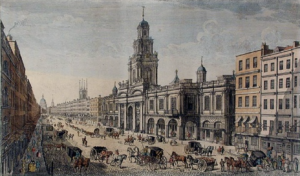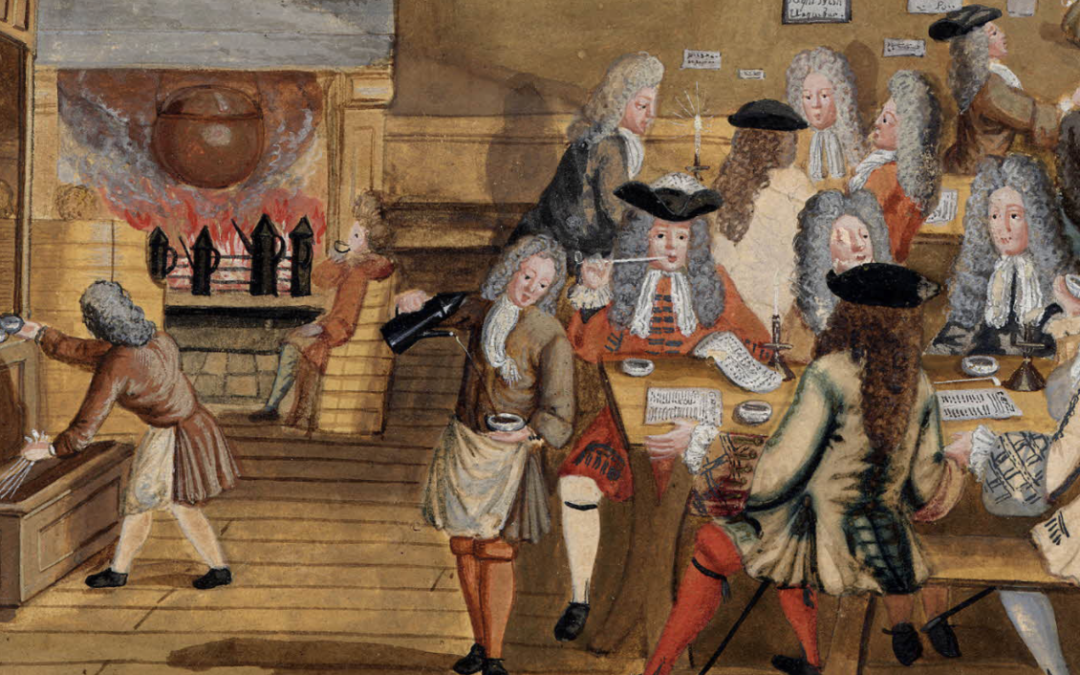Anna Brinkman-Schwartz’s latest article ‘The heart of the maritime world: London’s ‘mercantile’ coffee houses in the Seven Years’ War and the American War of Independence, 1756–83′ (open access) is published in the latest issue of Historical Research. Here she explains more about ‘mercantile’ coffee houses, where many topics were discussed.
London coffee houses of the late eighteenth century often evoke images of men like James Boswell and Dr. Johnson sitting in crowded, tobacco-smoke filled rooms discussing politics, plays, literature, or art. A simple image search on Google for ‘eighteenth-century coffee house’ will return prints and paintings depicting men involved in heated discussions or reading newspapers while being served coffee by young boys or older women. But what was going on in these heated discussions? What was in the newspapers that was of such interest? It was not only politics and literature; in many of London’s coffee houses, particularly those found within the City and the area around Cornhill and St. Paul’s, the topics at hand were about shipping, auctions, trade, and maritime affairs. The men, and occasional women, holding these discussions were ship captains, brokers, merchants, and sailors. In my article, I have dubbed these coffee houses London’s ‘mercantile coffee houses’. This is, of course, not a term that contemporaries used, nor were there exclusively ‘mercantile’ and ‘literary’ coffee houses. However, there were coffee houses where business and trade was the norm and it is on these that my research in the article focuses.
The article presents the argument that mercantile coffee houses played a vital role in Britain’s maritime community during the Seven Years’ War (1756-63) and the American War of Independence (1775-83) because they functioned as hubs of Britain’s global maritime networks. Fundamentally, mercantile coffee houses served two purposes. They provided a physical space for patrons to meet, conduct business, and manage mercantile affairs with an air of public legitimacy. They also provided a space where people could seek out and discuss news and information in both printed and verbal forms. The article examines how mercantile coffee houses functioned as both private and public spaces and why people chose them as venues for conducting maritime business during two of Britain’s global, and heavily maritime, conflicts.
Writing and researching this article was a multi-year project because of the nature of the sources. I became interested in the topic of mercantile coffee houses whilst I was still a PhD student looking into the history of prize courts. When looking through the High Court of Admiralty records in the UK National Archives, I noticed that many of the letters found on board captured ships were addressed to individuals at coffee houses in London. This piqued my interest and I began to keep lists and transcripts of envelops and letters addressed to coffee houses. I also began to take specific note of references to coffee houses made in correspondence that I encountered during my research. Because I was interested in prize affairs, I delved into the world of eighteenth-century newspapers in order to find references to captured ships and prize cases. I learned that not only were prize auctions widely held in mercantile coffee houses, but that many other types of auctions were held in coffee houses too. Brokers advertised that they could be found and contacted in coffee houses; ship captains also advertised that they could be found in coffee houses at certain times if people wanted to discuss freighting or buying goods; privateer captains advertised that men looking to sign up as sailors could come to certain coffee houses at certain hours to speak with the captain. In short, looking at newspapers that catered to the mercantile and maritime populations made it clear that coffee houses were important hubs of London’s maritime world.

London’s royal exchange in 1781. The surrounding area was a popular location for mercantile coffee shops. Image from Wikipedia.
As I continued to gather incidental references to coffee houses, I also began to actively seek out material that would help me build an understanding of coffee houses as public and private spaces for conducting mercantile affairs. This took me to the London Metropolitan Archives where the journal of a London based shipping merchant, John Eliot III, is kept. Eliot’s journal was an invaluable source for the article because he records when he went to coffee houses, which coffee houses he went to, who he was meeting, and why. His dealings with brokers, insurers, buyers and sellers of goods, are all elaborated upon in the journal. Eliot’s business life was overwhelmingly conducted in coffee houses and the royal exchange. He visited a variety of coffee houses every week. Eliot’s journal is the most comprehensive documentation I found of how merchants used coffee houses to conduct private and public business. However, his experience is substantiated by a patchwork of correspondence found within archives ranging from those in London, Madrid, Seville, New York, and Jamaica.
The varied and far-flung nature of the archival material gathered for this article meant that it stayed on my publication ‘back burner’ for a long time before I felt I had gathered enough research to finally write an article about London’s mercantile coffee houses and their role in Britain’s maritime world. I see this article as a contribution to the historiography of coffee houses, early modern networks and newspapers, and maritime Britain. The article builds on previous scholarship and seeks to add nuance to our understanding of how coffee houses were used by London’s maritime community in times war.
Featured image: Interior of a London coffee-house, The British Museum


